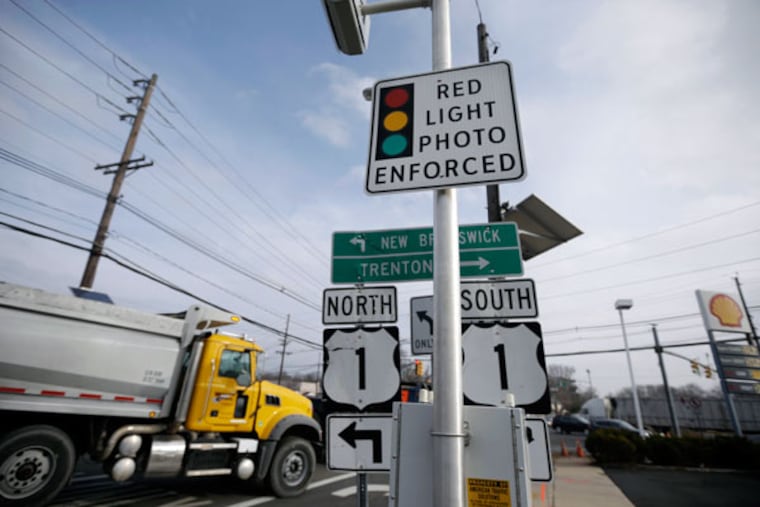Not enough evidence to evaluate red-light cameras
A few years back, right around Christmas, I got a surprise in the mail that was anything but a gift: a speeding ticket from a town right outside Washington in Montgomery County, Md. My crime: going 38 m.p.h. in a 30 m.p.h. zone.

A few years back, right around Christmas, I got a surprise in the mail that was anything but a gift: a speeding ticket from a town right outside Washington in Montgomery County, Md. My crime: going 38 m.p.h. in a 30 m.p.h. zone.
A couple years later, another family Thanksgiving in Washington yielded a similar December surprise: a ticket for running a red light, with the proof once again right there in the envelope. Yup, that was a grainy shot of our minivan midway through a Wisconsin Avenue intersection, the signal plainly on red.
Both incidents came to mind this week, a week after New Jersey allowed its five-year experiment with red-light cameras to lapse and days after a Chicago Tribune study cast new doubts on the efficacy of the Windy City's extensive system, which posts electronic eyes at more than 350 intersections.
Commissioned by the Chicago paper, two Texas A&M researchers used a sophisticated statistical methodology and concluded that the city's cameras appeared to cut injurious right-angle crashes by 15 percent but prompted an offsetting 22 percent rise in injurious rear-end crashes.
What does my experience have to do with this? Thankfully, no one was injured, unless you count pain to my bank balance. I was peeved that Maryland was allowing a high-tech version of an old-fashioned speed trap, but mollified by the limited consequences. Because the cameras can't really show who's driving, most states don't allow points to be assessed on the motorists they finger.
Still, I've been struck by how those two tickets affected my behavior - or didn't. I'm much more scrupulous about obeying speed limits whenever I see "camera enforced" signs. But at red lights, I'm no more or less prudent than I ever was - with the possible exception of being more likely to slam on the brakes if green turns to yellow at the worst possible moment.
That's what the Tribune's study suggests happens to many drivers - particularly as Chicago hews to minimal, three-second yellow lights even when traffic flows make that a dangerously short transition.
The Tribune called the Texas research a "first-ever scientific study," which apparently refers to its use of Bayes method statistics to account for confounding factors such as declining overall accident rates.
The paper's findings appear to refute claims by Chicago Mayor Rahm Emanuel that the cameras deserve credit for a 47 percent decline in particularly dangerous right-angle crashes. But it's less clear how they dovetail with earlier evidence, such as a 2011 study published in the Journal of Safety Research, that shows the cameras boosting safety.
Institute spokesman Russ Rader said that study, by IIHS researchers who compared large cities with red-light cameras to those without, found the cameras "reduced the fatal red-light-running crash rate by 24 percent and the rate of all types of fatal crashes at signalized intersections by 17 percent."
Rader suggested the Tribune's study may have overlooked a key aspect of crashes: their severity. Seatbelts, airbags, and even a car's sheet metal are less effective at protecting drivers and passengers when a car is hit at a right-angle, or "T-boned," often the result if a driver runs a red.
Despite such evidence, critics of red-light camera programs say they're at best one piece of the puzzle - and, as revenue generators for cities that adopt them and the private firms that administer them, the source of a dangerous conflict of interest. A bribery scandal involving Chicago's camera contractor tainted its New Jersey program, too.
Berwyn resident Tom McCarey, a longtime critic of the cameras, complains that Pennsylvania officials have dragged their feet on changes, such as lengthening yellow lights to realistically reflect traffic flow, that he says could reduce rear-end crashes. He says longer yellows would especially help at camera-equipped intersections, where drivers are more likely to brake suddenly.
McCarey suggests another statistic from Chicago may be the most important one: that the city has collected more than half a billion dollars from violators since 2002. "It's completely for revenue," he says.
I'd like to believe he's wrong. But so far, the evidence seems a little too grainy to trust.
215-854-2776 @jeffgelles